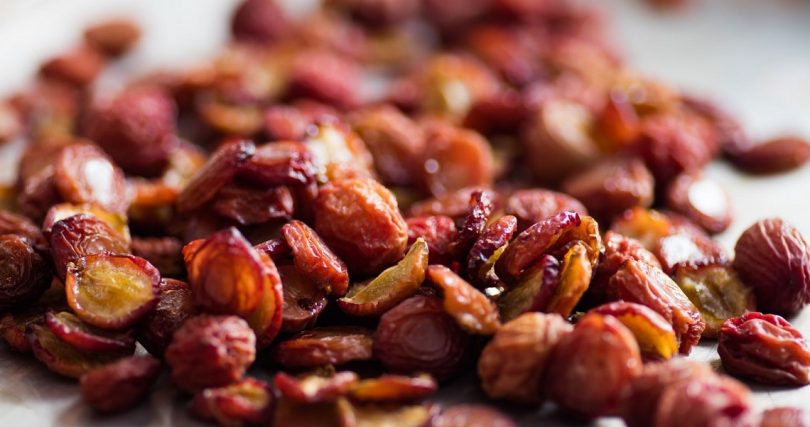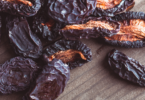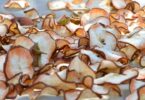Find out, what are the easiest methods of dehydrating grapes.
Here are tips on how to get started right with dehydrating grapes:
- Get acquainted with your drying appliance. For example, there are 3 categories of dehydrators: back fan, bottom fan, and top fan. Most food drying aficionados use back fan dehydrators for even drying. A back fan, however, will still require that you turn the tray around for consistent, even drying.
- In lieu of a dehydrator, use your oven. You could blanch the grapes first. This process will crack the grape skins allowing moisture to escape, giving way to faster dehydration. You may also cut the grapes in halves for the same reason.
- Don’t dehydrate grapes with another family of foods. Although fruits could be mixed together in a single drying, it is not generally recommended, especially if the other fruits have an overpowering taste and smell.
- Storage is very important for dehydrated grapes. You may store your raisins in metal containers, glass jars, or Ziplocks.
READ ALSO: How to Store Dried Fruits at Home
Easy Methods of Dehydrating Grapes
Both varieties of grapes – seedless green and seedless red—are excellent for dehydrating. You may use seeded grapes, but you definitely have to halve and remove the seeds before drying.
Preparing your grapes
Wash the grapes thoroughly. You may just wash with water and a scrub brush. You may use any of the following homemade solutions for effective washing. For all solutions, scrub and rinse well after soaking.
- 1 part apple cider vinegar to 10 parts water. Let the grapes sit for 5 minutes.
- 1 part white vinegar combined to 3 parts tap water. Soak the grapes for 5-10 minutes.
- 1 tablespoon 3% hydrogen peroxide to 1 gallon of water. Soak for 5 minutes.
- 1 teaspoon of salt for 1 cup of water. Soaking time is 2 minutes. Scrub and rinse well.
- 2 teaspoons bleach to 1 gallon of water.
- 1 teaspoon castile soap to 1 gallon of water. You may opt to add 7 drops citrus essential oil into the mixture.
Here is a small video about how to wash grapes.
Remove the grapes from the stems after washing. Air drying is optional as they will dry up in the dehydrator anyway. But if you don’t want to mess up your dehydrator, you may always place your grapes in a colander and let them drip for an hour.
If you are using seeded grapes, cut them in halves to remove the seeds.
Dehydrating grapes in a food dehydrator
- Arrange the grapes evenly on the dehydrator tray in a single layer. It shouldn’t be a problem if the fruits touch one another.
- Set the temperature to the “fruit” setting. That’s 135°F.
- Allow the grapes to dehydrate for 24-48 hours. Check on the grapes every 6-8 hours to see the rate at which they are drying.
You can expedite the dehydrating process by raising the temperature to 145°F for the first 12 hours. Then, reset to 135°F to prevent burning or over-drying.
As the grapes dry, they will release water and juices producing spots on the area where liquids escaped. It is necessary to shuffle every 8 hours to prevent sticking on trays, particularly if you are using the red variety.
If you have difficulty testing for “doneness”, turn the dehydrator off, and let cool for 30 minutes before tasting.
Two pounds of grapes yield about two 16-ounce glass jars of raisins. Dried green grapes are noticeably larger than dried reds.
Dehydrating grapes in the oven
- Make sure that your oven can register a temperature setting that’s as low as 140°F. Otherwise, your grapes will cook instead of dehydrating at a higher temperature.
- To allow for air circulation, leave the oven door open about 2 to 6 inches. You can improve air circulation by placing a fan near the oven door. Keep the kitchen off-limits to kids when doing this drying method.
- To monitor and maintain oven temperature at 140°F, place an oven thermometer near the grapes.
- Make sure that the trays are narrow enough not to touch the sides and should be 3 to 4 inches shorter on the front and back. When using multiple trays, make sure that they are 2 to 3 inches apart for good air circulation.
Drying time should take about 4 hours depending on the variety of your grapes, your oven, and your preferred degree of doneness. Visually, you may consider your raisins done when nicely shriveled but still slightly plump.
SEE ALSO: 5 Easy Steps for Drying Grapes in the Oven
You may store your dried grapes in a sealed container in the refrigerator for 3 weeks. Dryer grapes keep longer.
Sun-drying grapes
- Arrange the grapes on a baking tray. Don’t let the grapes touch one another.
- Cover the grapes with a kitchen towel. You may also use a pillowcase. Just be sure to weigh down the cover so it won’t be blown away and serve well their purpose of preventing bugs from getting to the fruits.
- Put the grapes out in the sun for at least 3 days. On humid nights, take the grapes inside and then take them out again the following day.
Remove grapes that might have been dampened or rotten even before they shriveled and turned to raisins.
After 3 days, remove your raisins from the tray and store in glass or metal containers.
One of the benefits of eating dehydrated grapes is that they are an easy and quick way to pack a nutritional punch. When grapes are dried, the nutrients become more concentrated, making it a snack rich in iron, potassium, carbohydrates, and B vitamins all rolled into delightfully sweet and tangy bite sizes.





